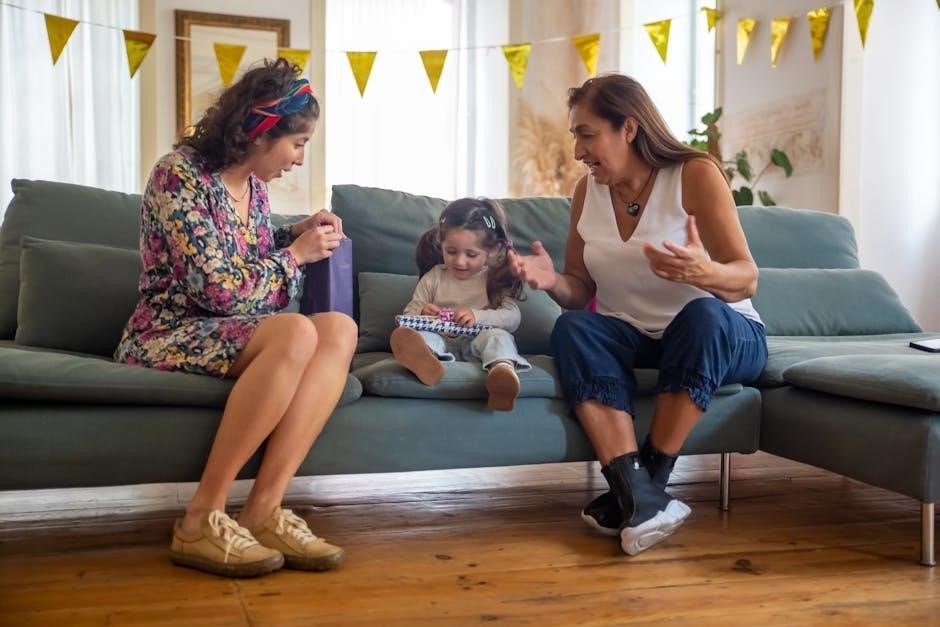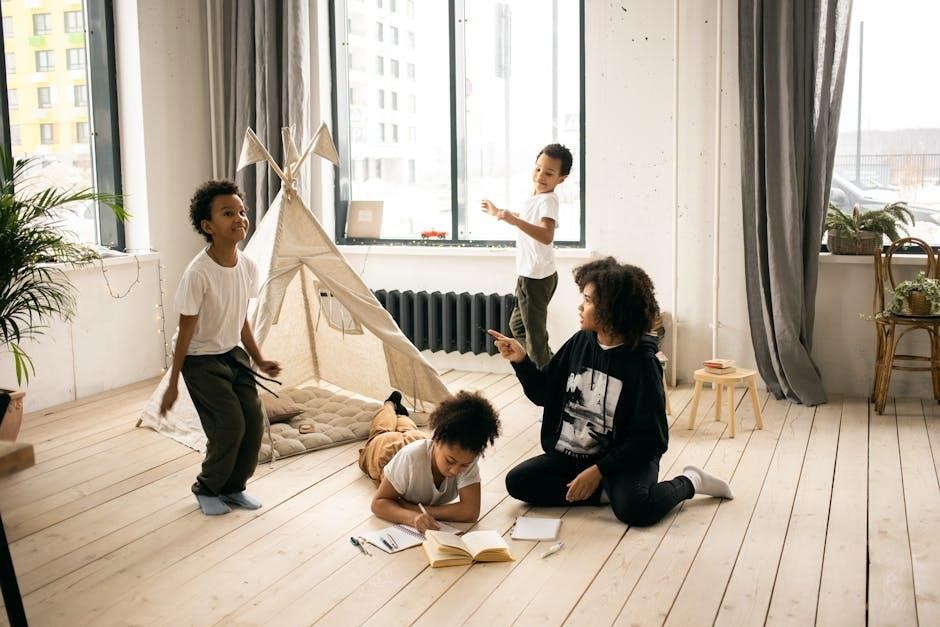
“Live Together, Play Together” emphasizes unity and multicultural harmony, fostering togetherness through shared experiences. This speech explores the significance of cooperation, diversity, and collective growth in modern societies.
1.1 Definition and Significance of “Live Together, Play Together”
“Live Together, Play Together” is a philosophy promoting unity and multicultural harmony. It encourages collaboration, mutual respect, and shared experiences to foster a cohesive society. Originating from ideals of equality and justice, this concept has evolved into a cornerstone for building inclusive communities. By emphasizing collective growth and understanding, it bridges cultural divides, inspiring individuals to work together toward common goals. Its significance lies in its ability to break down barriers and create environments where diversity thrives.
1.2 Purpose and Scope of the Speech
The purpose of this speech is to explore the essence of “Live Together, Play Together,” emphasizing unity, diversity, and collective growth. It aims to inspire audiences to embrace multiculturalism and collaborate toward common goals. The scope includes addressing historical roots, educational roles, and community-building strategies. By highlighting personal development and global examples, the speech seeks to empower individuals and communities, fostering inclusivity and understanding. Its ultimate goal is to encourage active participation in creating a harmonious, interconnected world.
Historical Context
The phrase “Live Together, Play Together” emerged during the 1960s Civil Rights Movement, reflecting a vision of unity and equality. It symbolizes societal efforts to bridge divides and foster collective progress through shared experiences and mutual understanding. This historical backdrop underscores the speech’s relevance in addressing multiculturalism and collaboration, highlighting the enduring importance of unity in diverse communities.
2.1 Origins of the Phrase
The phrase “Live Together, Play Together” traces its origins to the 1960s Civil Rights Movement, emphasizing unity and equality. It gained traction through sports, symbolizing efforts to bridge divides. The phrase reflects a vision of collective progress, resonating with movements advocating for multicultural harmony. Its enduring relevance highlights the importance of unity in diverse communities, making it a powerful theme in modern discourse on togetherness and inclusivity.
2.2 Key Historical Events Promoting Unity
The Civil Rights Movement, led by figures like Martin Luther King Jr., significantly advanced unity by advocating for equality and justice. Sports, such as basketball in Virginia, became platforms for bridging cultural divides. Initiatives in multicultural settings, like those in Greece addressing socio-political changes, further promoted togetherness. Programs in Australia, such as “Play Together Learn Together,” fostered inclusivity among refugee families. These events underscored the power of collective action in building harmonious, diverse communities.
2.3 Influential Figures in Promoting Multiculturalism
Figures like Martin Luther King Jr. and Nelson Mandela played pivotal roles in advocating for unity and multiculturalism. King’s leadership in the Civil Rights Movement and Mandela’s vision of a united South Africa inspired global efforts toward inclusivity. Community leaders, such as Andrew Daniels, used sports to bridge cultural divides, while initiatives like “Play Together Learn Together” in Australia empowered refugee families. These individuals and programs exemplify the power of leadership in fostering multicultural harmony and social cohesion.

Multiculturalism
Multiculturalism celebrates diversity, fostering inclusivity and unity. It promotes mutual respect, understanding, and cooperation among diverse groups, enriching societies through shared experiences and collective growth.
3.1 Benefits of Multicultural Societies
Multicultural societies offer numerous benefits, including enhanced creativity, innovation, and economic growth. Diverse perspectives foster problem-solving and cultural exchange, enriching communities. They also promote empathy and understanding, reducing prejudice and conflict. By valuing differences, multicultural societies create inclusive environments where individuals thrive collectively. This unity strengthens social cohesion, leading to a more harmonious and resilient society. Ultimately, multiculturalism serves as a foundation for a vibrant, interconnected world.
3.2 Challenges in Multicultural Integration
Multicultural integration faces challenges such as communication barriers, cultural misunderstandings, and resistance to change. Diverse groups may struggle to find common ground, leading to potential conflicts. Additionally, societal biases and unequal access to resources can hinder unity. Educators and community leaders play a crucial role in addressing these issues by fostering dialogue and promoting inclusive practices. Overcoming these challenges requires patience, empathy, and a collective commitment to understanding and valuing diversity.
3.3 Successful Multicultural Programs
Programs like “Learning to Play Together” in Greece and Australia have successfully promoted unity through play, fostering intercultural understanding. These initiatives engage diverse groups in shared activities, breaking down barriers. Similarly, community-driven projects like the Multicultural Perspectives Public Speaking Competition in NSW encourage dialogue and empathy. Such programs highlight the importance of inclusive spaces where individuals can connect, learn, and grow together, ultimately strengthening multicultural harmony and societal cohesion.

Education
Educational programs fostering unity through interactive activities and cultural awareness are vital. Schools play a key role in promoting empathy and understanding among diverse groups, enriching multiculturalism.
4.1 Role of Schools in Promoting Unity
Schools play a pivotal role in fostering unity by creating inclusive environments that celebrate diversity. Through multicultural education and interactive activities, students develop empathy and understanding. Programs like “Learning to Play Together” encourage collaboration, breaking down cultural barriers. Educators emphasize shared values, promoting a sense of belonging. By teaching conflict resolution and cultural awareness, schools equip students with essential skills for harmonious coexistence. These efforts prepare future generations to thrive in diverse societies, fostering a culture of unity and mutual respect.
4.2 Teaching Empathy and Cultural Awareness
Teaching empathy and cultural awareness is crucial for fostering unity; Schools use interactive activities, storytelling, and group projects to help students understand diverse perspectives. Programs like “Learning to Play Together” encourage collaboration, breaking down cultural barriers. Educators emphasize shared values, promoting a sense of belonging. By teaching conflict resolution and cultural awareness, schools equip students with essential skills for harmonious coexistence. These efforts prepare future generations to thrive in diverse societies, fostering a culture of unity and mutual respect.
4.3 Case Studies of Successful Educational Programs
Successful programs like “Learning to Play Together” in Australia and “Multicultural Perspectives” in NSW showcase effective educational strategies. These initiatives use play-based learning to build relationships and cultural understanding. For instance, Broadmeadows Women’s Community House engaged refugee families through supported playgroups, fostering empathy and unity. Similarly, the MPPS competition encouraged students to articulate multicultural ideals, demonstrating the power of education in promoting diversity. These examples highlight how tailored programs can bridge cultural divides and empower future generations.

Community Building
Community building strengthens bonds through shared activities, fostering unity and inclusivity. Events and collaborative efforts create spaces for connection, breaking down social barriers and promoting collective growth.
5.1 Community Activities Fostering Togetherness
Community activities, such as collaborative sports, cultural festivals, and shared workshops, play a vital role in fostering togetherness. These events encourage individuals from diverse backgrounds to interact, breaking down social barriers and fostering mutual understanding; By participating in group endeavors, people develop empathy and trust, which are essential for building cohesive communities. Such initiatives not only strengthen relationships but also promote a sense of belonging, ensuring that diversity becomes a source of collective strength rather than division.
5.2 Role of Community Events
Community events, such as cultural festivals, sports tournaments, and workshops, serve as powerful tools for unity. They create opportunities for individuals from diverse backgrounds to connect, fostering mutual respect and understanding. These gatherings not only celebrate diversity but also encourage collaboration, helping to break down social and cultural barriers. By participating in shared experiences, communities can build stronger bonds, promoting a sense of belonging and collective identity. Such events are essential for nurturing inclusivity and harmony in multicultural societies.
5.3 Overcoming Barriers in Community Building
Community building often faces challenges like cultural differences, language barriers, and socioeconomic disparities. To overcome these, active listening, empathy, and open dialogue are essential. Inclusivity and accessibility must be prioritized, ensuring all voices are heard. Collaborative efforts, such as shared goals and teamwork, can bridge divides. By fostering mutual respect and understanding, communities can transcend obstacles, creating a united and supportive environment for all members to thrive and grow together effectively.

Conflict Resolution
Engaging in shared activities fosters understanding and reduces tensions, promoting unity. Sports and collaborative efforts serve as tools to bridge divides and build harmonious relationships effectively.
6.1 Strategies for Conflict Resolution
Effective conflict resolution involves active listening, empathy, and open dialogue. Encouraging teamwork through shared activities, like sports, fosters mutual understanding. Teaching problem-solving skills and promoting inclusivity helps bridge cultural divides. Andrew Daniels’ approach to conflict transformation through basketball highlights how collaborative efforts can unite diverse groups. By addressing misunderstandings and fostering respect, communities can resolve conflicts constructively, leading to stronger, more harmonious relationships.
6.2 Role of Sports in Bridging Divides
Sports play a pivotal role in bridging cultural and social divides, fostering unity and mutual respect. Andrew Daniels’ experience coaching a diverse high school basketball team exemplifies how sports can transform conflicts into opportunities for growth. By encouraging teamwork, sports break down barriers, promote empathy, and build trust among individuals from varied backgrounds. This shared platform cultivates understanding and strengthens community bonds, proving that unity is achievable through collective effort and playful collaboration.
6.3 Case Study: Conflict Resolution in Multicultural Settings
A case study involving Andrew Daniels’ high school basketball team in Virginia highlights how sports can resolve conflicts in multicultural settings. The team, comprising players from diverse cultural and socioeconomic backgrounds, faced initial tensions. Through structured team-building activities and inclusive coaching, Daniels fostered mutual respect and understanding. The team’s transformation from discord to unity demonstrates how shared goals and playful collaboration can bridge divides, proving that sports are a powerful tool for conflict resolution in multicultural environments.

Personal Development
Personal growth thrives in multicultural environments through empathy, storytelling, and inclusivity. Shared activities foster understanding, while diverse interactions empower individuals to embrace unity and cooperation wholeheartedly.
7.1 Essential Skills for Multicultural Environments
Effective communication, empathy, and conflict resolution are vital in multicultural settings. These skills bridge cultural divides, fostering collaboration and mutual respect. Learning to navigate diverse perspectives enhances unity and cooperation, creating a harmonious society where individuals thrive together.
7.2 Power of Storytelling
Storytelling is a powerful tool for connecting people across cultures, fostering empathy and understanding. By sharing personal experiences and cultural narratives, individuals can bridge divides and promote unity. Stories highlight shared humanity, enabling others to relate and appreciate diverse perspectives. This exchange enriches communities, encouraging collaboration and mutual respect, which are essential for a harmonious society.
7.3 Empowering Individuals Through Inclusivity
Inclusivity empowers individuals by creating environments where diverse voices are valued and respected. Programs like “Learning to Play Together” foster intercultural understanding, enabling people to thrive in multicultural settings. By promoting equality and active participation, inclusivity helps build confidence and resilience. It encourages individuals to embrace their unique identities while contributing to a cohesive society, ultimately strengthening community bonds and fostering a culture of mutual respect and collaboration.

Global Examples
Initiatives like “Learning to Play Together” in Greece and Australia promote intercultural understanding, fostering unity and inclusivity among diverse communities worldwide, empowering individuals collectively.
8.1 International Multicultural Initiatives
Programs like “Learning to Play Together” in Greece and Australia focus on fostering unity through play, promoting cross-cultural understanding. These initiatives encourage collaboration, breaking down barriers and celebrating diversity. By engaging diverse groups in shared activities, they cultivate empathy and mutual respect. Such global efforts highlight the power of inclusive play in strengthening multicultural bonds and fostering a sense of belonging. These initiatives serve as powerful models for building harmonious societies worldwide, proving that unity can be achieved through shared experiences and mutual understanding.
8.2 Interfaith Dialogue and Collaboration
Interfaith dialogue fosters understanding and respect among diverse religious communities, promoting unity. Initiatives like interfaith sports events and community projects encourage collaboration, breaking down stereotypes. By engaging in open conversations and shared activities, individuals build bridges across faiths, strengthening social cohesion. These efforts highlight the power of mutual respect in creating harmonious societies. Such collaborations not only enhance empathy but also pave the way for peaceful coexistence, proving that unity can be achieved through shared values and collective action.
8.3 Refugee Integration Programs
Refugee integration programs play a vital role in fostering unity and inclusivity. These initiatives often include community activities, language classes, and cultural exchange events. By engaging refugees in shared experiences, such as sports and communal projects, these programs help build bridges between diverse groups. They also provide essential support, enabling refugees to adapt to new environments. Such efforts not only promote social cohesion but also empower individuals to contribute positively to their new communities, creating a foundation for lasting harmony and mutual respect.
Technology’s Role
Technology bridges divides through digital platforms and online communities, fostering inclusivity and collaboration. Gamification in education enhances multicultural learning, promoting unity and shared growth.
9.1 Digital Platforms for Unity
Digital platforms serve as powerful tools for fostering unity by connecting diverse groups globally. Social media, collaborative apps, and online forums create spaces for dialogue and shared activities, promoting multicultural understanding. These technologies enable cross-cultural exchanges, breaking down barriers and encouraging empathy. By leveraging digital tools, communities can engage in joint projects, celebrate diverse traditions, and address common challenges collectively. This digital interconnectedness strengthens social bonds and paves the way for a more inclusive and harmonious society.
9.2 Online Communities Promoting Inclusivity
Online communities play a vital role in fostering inclusivity by connecting individuals from diverse backgrounds. Platforms like forums, social media groups, and collaborative apps enable people to share experiences, traditions, and ideas, breaking cultural and geographical barriers. These spaces encourage open dialogue, empathy, and mutual understanding. By engaging in shared activities and discussions, individuals strengthen social bonds and promote unity. Such communities exemplify how digital spaces can celebrate diversity and create a sense of belonging, ultimately enriching multicultural interactions and fostering global harmony.
9.3 Gamification in Multicultural Education
Gamification in multicultural education engages learners through interactive games and activities, fostering cultural exchange and understanding. Platforms like “Learning to Play Together” use physical education to promote ethical values and intercultural learning. By incorporating challenges and rewards, these tools make diversity education enjoyable and accessible. Such approaches encourage teamwork, empathy, and mutual respect, preparing individuals to thrive in diverse environments while building a foundation for harmonious coexistence and shared growth.

Environmental Connection
Shared environmental activities foster connections, encouraging community spirit and sustainable living. Playing together outdoors promotes care for our planet and strengthens bonds among diverse groups.
10.1 Shared Green Spaces
Shared green spaces are vital for fostering community connections and environmental stewardship. Parks, gardens, and playgrounds serve as neutral grounds where diverse groups can interact and collaborate. These spaces encourage collective responsibility for maintaining ecosystems, promoting sustainability, and creating inclusive environments. Through shared activities like clean-up initiatives or outdoor games, individuals build bonds and develop a sense of shared ownership. Such efforts not only enhance environmental awareness but also strengthen social cohesion, reflecting the “Live Together, Play Together” ethos in action.
10.2 Promoting Sustainability Together
Promoting sustainability together strengthens community bonds while addressing environmental challenges. Collaborative efforts like neighborhood clean-up days or tree-planting initiatives foster teamwork and shared responsibility. Such activities encourage individuals to contribute to a common goal, fostering unity and environmental consciousness. When communities work together to promote sustainability, they not only protect the planet but also build lasting relationships, embodying the spirit of “Live Together, Play Together” through collective action and shared commitment to a greener future.

Public Speaking Tips
Prepare palm cards, focus on multicultural themes, and ensure a smooth speech flow. Speak confidently, maintain eye contact, and use a clear, audible voice to engage listeners effectively.
11.1 Speech Structure for Maximum Impact
A well-structured speech ensures clarity and engagement. Start with a strong introduction that grabs attention, followed by a logical flow of ideas in the body. Use clear transitions to connect points, and conclude with a memorable closing. Ensure each section supports the central theme of unity and multiculturalism, using personal anecdotes or examples to illustrate key messages. Practice delivery to maintain a confident tone and pace, ensuring your speech resonates with the audience.
11.2 Effective Delivery Techniques
To deliver a compelling speech, focus on engaging your audience with confidence and passion. Use palm cards for key points, maintaining eye contact and varying your tone for emphasis. Practice your speech to master pacing and pauses, ensuring clarity. Incorporate gestures and body language to convey enthusiasm. Encourage audience interaction through rhetorical questions or relatable anecdotes. Above all, speak from the heart, connecting emotionally with your listeners to inspire unity and understanding.
- Practice thoroughly to ensure smooth delivery.
- Use voice modulation to highlight key messages.
- Engage with the audience through eye contact and gestures.
11.3 Engaging the Audience
Engaging your audience is crucial for a impactful speech. Start with a relatable story or anecdote to capture their attention. Use rhetorical questions or interactive elements to involve them directly. Incorporate universal themes like shared values and common goals to foster connection. Maintain eye contact, use expressive body language, and vary your tone to keep listeners interested. Conclude with a powerful call to action, inspiring the audience to embrace unity and take steps toward creating a harmonious community.
- Begin with a personal or relatable story.
- Encourage interaction through questions or discussions.
- Use emotive language and gestures to connect emotionally.
- Unity strengthens communities.
- Diversity enriches our shared humanity.
- Together, we create a harmonious world.
12.1 Recap of Key Points
The speech emphasizes the importance of unity, diversity, and collaboration. Historical roots in the 1960s Civil Rights Movement highlight the struggle for equality. Multiculturalism fosters mutual respect and understanding, while education and community activities promote empathy and togetherness. Sports, like basketball, bridge cultural divides, and personal growth through inclusivity empowers individuals. Global initiatives and technology further advance unity, showcasing humanity’s shared goals and the power of collective action for a harmonious future.
12.2 Call to Action for Unity
Unity begins with collective effort. Let us embrace diversity, participate in community events, and foster open dialogue to bridge divides. By celebrating our differences and promoting empathy, we can build a society where everyone feels valued. Each small action, from shared green spaces to multicultural education, contributes to a harmonious future. Together, we can create a world where “live together, play together” is not just a phrase, but a way of life.
12.3 Vision for a United Future
A united future envisions a world where diversity is celebrated, and inclusivity is the foundation of every community. By fostering multicultural initiatives and interfaith collaboration, we can create societies that thrive on shared values. Education and community building will play pivotal roles in nurturing empathy and understanding. Through collective efforts, we aim to build a future where every individual feels a sense of belonging, and “live together, play together” becomes a universal reality, guiding humanity toward harmony and prosperity.

Additional Resources
Explore recommended reading, research articles, and speech PDFs for deeper insights into multiculturalism and unity. These resources offer practical guides and inspiring stories to foster togetherness globally.
13.1 Recommended Reading
Discover insightful resources like “Learning to Play Together” and “Play Together Learn Together” booklets, offering practical activities for fostering unity. Explore the “Live Together, Play Together” speech PDF for a comprehensive guide on multiculturalism. These materials provide engaging strategies for educators and families to promote inclusivity and understanding. Additionally, “The Multicultural Perspectives Public Speaking Competition” materials offer tips for crafting impactful speeches on unity. Access these resources to deepen your understanding of building harmonious communities.
13.2 Relevant Articles and Research
Explore articles like “Learning to Play Together” and research by H. Starkey (2015), which highlights Mandela’s vision of unity. Discover how the phrase “Live Together, Play Together” emerged in the 1960s, reflecting Civil Rights Movement ideals. These sources provide a deeper understanding of multiculturalism and its historical roots, offering insights into fostering inclusive communities. Access these materials to enrich your speech with well-researched and impactful content.
13.3 Accessing the Speech PDF
To access the “Live Together, Play Together” speech PDF, visit the official NSW Public Speaking Competition website. Search for Multicultural Perspectives Public Speaking Competition (MPPS) resources. The PDF includes speech guidelines, sample outlines, and tips for engaging delivery. Ensure to review the document for insights into crafting compelling speeches that reflect unity and diversity. This resource is essential for participants preparing for the competition and seeking to inspire through their words.